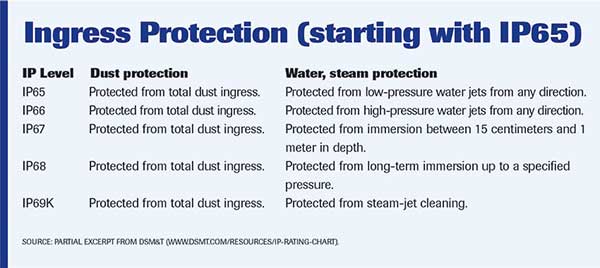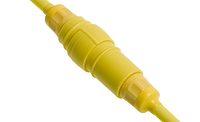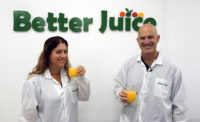Pressure measurement, key to ensuring food safety and quality, uses sensing techniques that have been around for a while. But recently, the food and beverage industry has benefited from advances in the precision of modern intelligent devices, paired with their ability to withstand harsh environments and ingredients.
Most pressure instrumentation manufacturers have had plenty of time to practice their craft in other industries, such as chemicals, paper, and oil and gas refining. Sensors have had to withstand powerful oxidizers, lye, salts, slurries and nasty hydrocarbons—not to mention superheated steam and/or vibration. So, it wasn’t much of a stretch to come up with devices for the food and beverage industry that could handle some demanding applications.
And while the chemical and refining industries have come to take high accuracy and precision for granted, our industry benefits from all these technological advances, so that applications like drying, edible-oil refining, winemaking and yogurt production can be fine-tuned to minimize waste, increase efficiency and produce consistent, high-quality products.
Pressure sensors are typically asked to handle three types of pressure measurement: gauge (aka gage), absolute pressure and differential pressure or DP. Gauge pressure is measured with reference to atmospheric pressure; absolute pressure is referenced to a vacuum, and DP is not measured with reference to a specific pressure, that is, DP measures the difference of two pressures. DP can be useful in not only measuring pressure, but in computing other process variables, such as level or volume, as is shown in the following application.
Caviro, a large Italian wine-producing cooperative, needed to bring its storage vessels and bottling operations up to snuff. The problem plaguing the winery was its uncertainty of how much wine the vessels contained, therefore, making it difficult to accurately plan filling. Too few or too many bottles meant wasted production time and labor in either securing more bottles for a batch or carting empty bottles back to storage.
To make it easy to manage production of a very complex variety of wines, S.A.I.I.E. srl, an advanced automation supplier, installed a range of sensors in the wine storage areas. These included Siemens SITRANS LR 250 tank radar level meters, FM MAG 6000 flowmeters with FM MAG 1100 SS sensors and P DS III pressure transmitters set up in a DP configuration to measure a vessel’s volume.
But there was a problem: Radar tank level transmitters were the sensor of choice, but they had to be installed at the top of a vessel, and for a portion of these containers, there was insufficient headroom. To solve the problem of getting level or volume measurement without a radar transmitter, S.A.I.I.E. installed at the bottom of the vessels the Siemens P DS III pressure transmitters, which continuously monitor the differential pressure, while a PLC converts that data to volume measurements.
With exact capacity/volume measurement of the storage vessels, Caviro ensures that each glass bottle, Tetra Pak or bulk bag is filled with the highest quality of wine. The filling process is fast paced, so real-time measurements are essential. Now, production issues can be fixed quickly before they turn into a problem.
“An advanced instrumentation and control system, such as the one provided by Siemens, allows us to concentrate on process quality,” says Domenico Dosio, general maintenance, investment and technical service manager at Caviro.
What it takes for food and beverage
The majority of electrical pressure transmitters use a flexible diaphragm as the pressure transmitting element, says Claudia Garcia, director of marketing at Ellison Sensors Inc. (ESI). By using the appropriate process connection, it is possible to produce flush-mounted pressure transmitters that have no cavities and are easy to clean.
Sanitary regulations require surface finishes for process connections that don’t collect bacteria that could contaminate the product, says Larry Myers, inside sales manager at Omega Engineering. The sensor must also be CIP enabled and able to be quickly disengaged from the process, so that the process port can be capped off for steam or chemical cleaning of the vessel or pipelines. Myers points to the Omega PX409S sensors, which meet these requirements, and are standard for the food and beverage and pharmaceutical industries.
“Temperature changes due to frequent and rapid switching from cold media to hot CIP (and vice versa) put a lot of demand on pressure sensors,” says Ola Wesstrom, food and beverage industry manager at Endress+Hauser.
Temperature effects on measurement need to be minimal and with fast recovery. This is particularly important when using pressure as a level sensor (hydrostatic pressure) in small tanks. Sensors must be temperature compensated to avoid over/under filling.
What about food safety?
“Naturally, anything intended for use in food and beverage production has to be configured appropriately using tri-clamp mounting and avoiding any surfaces able to trap liquid or promote bacterial growth,” answers Lee Hamlett, Yokogawa Corp. of America product manager, pressure products NA.
What other factors set food industry sensors apart from other industries? Doug Greaves, ABB measurement and analytics product manager (pressure), lists a few:
- Hygienic/sanitary process connections
- Aseptic steam connections
- Materials approvals
- CIP/SIP
- Low roughness on surface finishes
- Industry certification marks (e.g., 3-A, FDA, EHEDG).
“We maintain a food and beverage portfolio which meets 3-A and EHEDG standards,” says Paul Wagner, Anderson-Negele senior product and marketing manager. “This is mostly driven from the region in which we sell the product, as well as the process connection being offered.”
These standards are in place to ensure a product can be cleaned in or out of place. Also, the sanitary industries face constant external washdown with harsh chemicals, changing processes and ambient temperatures, and rough handling of instrumentation.
While meeting 3-A, FDA and EHEDG specifications is especially important to being food safe, pressure sensors are both mechanical and electronic devices, and they need to be protected from their environment and rough handling, if they’re expected to provide service over the years.
“We view an IP69K ingress protection as key to success,” Wagner adds. “Years of experience have taught us that condensing water vapor from a humid environment can destroy delicate electronics. For this reason, we fully encapsulate electronics in potting and use our patented dual O-ring seals in our new designs. Additionally, we weld our diaphragms using a proprietary process, which results in a surface finish better than 25 Ra, exceeding the 3-A standard for surface finish. Our products also offer stainless steel enclosures as standard and use plastics for caps, which are compatible with cleaning and foaming agents.”

For electronic connectors, ABB’s Greaves says users have a choice of using O-ring sealed straight-thread or NPT connections. The environmental protection of the transmitter housing for washdown can be specified from IP66 up to IP69K for steam-jet cleaning.
“Our preferred wiring connection is an M12 eurofast connector,” says Wagner.
These four- or five-pin quick-disconnect receptacles offer easy service for users and eliminate a direct water ingress point on the sensor’s housing. Additionally, this connector pairs with industry common molded cord sets, which Anderson-Negele also provides.
“Our designs aim to meet the IP69K ingress rating where possible,” says Wesstrom. “IP69K, combined with quick disconnect electrical connections, eliminates most ingress issues.”
A bigger challenge is to prevent condensation from forming inside electronic compartments.
“We address this by minimizing air volume and applying breather membranes [Gore-Tex],” he says. “This minimizes air pressure differences from inside/outside housing that can draw moisture into the housing as it cools.”
Emerson Rosemount’s 3051 pressure transmitter is also available for sanitary and hygienic applications. Wally Baker, Emerson Automation Solutions’ Rosemount global pressure content manager, says the hygienic version’s pressure transmitter has an accuracy of up to 0.065 percent reference and a five-year stability. It also meets 3-A, EHEDG and ASME-BPE standards; handles gauge and absolute static pressures to 300 psi; and works down to zero to five psi with 10:1 range-down capabilities, making it suited to buffer and balance tanks; comes standard with a 32 µin. surface finish for wetted parts (optional 15 µin. polish); withstands steam in place with a process temperature of 284°F for up to four hours; and has a vibration specification of less than ±0.1 percent (IEC60770).
Chlorine, acids, salts and alkalis
For sanitary sensors, Omega wetted parts are made of 316L SS, which contains molybdenum, says Myers. This stainless steel alloy provides effective resistance against corrosion and pitting in acidic and chloride solutions, and is better than other SS types commonly used on pressure transducers.
316L has an excellent chemical compatibility with the majority of cleaning agents used in low concentrations, says Wagner.
“In fact, we see more issues with high-chloride content process fluids, such as cheese brine or high-acid foods, such as tomato paste. For both of these applications, we would offer a C22 Hastelloy diaphragm or contact surface.”
Sanitary pressure sensors typically have a thin diaphragm (0.005 in. thick) and are often breached or destroyed before pitting is present on other surfaces. For this reason, Anderson-Negele offers an option for a 316L fitting and Hastelloy diaphragm.
In most cases, 316L SS is sufficient, says Endress+Hauser’s Wesstrom. On occasion, if sodium content is high with elevated temperatures, there may be a need to use a Hastelloy C (or equivalent) or ceramic membranes. A greater challenge is mechanical damage to membranes. Mechanical damage can be caused by manual handling or where abrasive media or impingement cleaning is used. Example applications include tomato paste, measuring the level of grain beds in brewing (as in a lauter tun) or fruit/vegetable transfer/wash lines where conventional membranes get dented.
Wesstrom explains the lauter tun has a particularly aggressive environment: In 1999, one brewery had to replace the transmitters it was using several times per year due to membrane damage.
“The challenge was eliminated when we installed multiple ceramic-based sensors, which are still in operation today,” he says.
Where more aggressive caustic or acid cleaning agents are used, Emerson’s Baker recommends using the Rosemount 1199 diaphragm seal, which consists of a number of exotic materials for the wetted surface. Likewise, Yokogawa’s Hamlett recommends the use of 329J4L SS to improve resistance to common CIP chemicals.
Variety of measurement applications
As was evidenced in the winery application, pressure sensors—and in this case, DP—can serve a multitude of applications, for example, measuring level or volume, flow (in certain instances) and pressure in various applications. Most pressure transmitters combine temperature measurement not only as an added process variable, but also to compensate pressure measurements in changing temperatures.
DP is commonly used in level measurement, says ABB’s Greaves. The low-side reference leg of a DP transmitter is how level can be inferred in closed tanks. Using the reference leg, one can compensate for pressure from nitrogen blanketing or vacuum-evacuated tanks—schemes that have a specific purpose in keeping ingredients fresh.
“[In] any level applications where a tank is closed to the atmosphere, a DP sensor must be used,” says Anderson-Negele’s Wagner.
These would include applications like pressure cookers, yogurt culture tanks or fermentation vessels. In these cases, the head pressure must be measured to determine the true level.
DP can also be used to infer density by measuring the pressure exerted by a volume between two fixed-position taps on a tank, adds Greaves. This concept can be extended to measuring the interface level of two materials with different known densities. The interface level is a linear function between these points. A processor can use this information to separate or recover materials.
Can DP do flow? It depends.
“The specialized equipment configurations for food and beverage applications preclude many of the traditional industrial installation techniques, such as conventional impulse lines, but there are mechanisms to solve the problem,” says Yokogawa’s Hamlett.
Yokogawa’s EJA117J unit is a hygienic DP instrument for applications, such as tank level measurement. Given the complexity of equipment configuration necessary to meet food and beverage requirements, there are other flow measurement techniques, such as magnetic and Coriolis, which are easier to use for these applications, says Hamlett.
DP flow measurements are rarely used in the food industry because, in most cases, the primary elements, pitot tube and orifice plates, are not good hygienic designs, adds Wesstrom. On the other hand, utilities, such as natural gas and airflow, can be measured with DP methods.
Nevertheless, ABB’s Greaves says that DP can provide a flow measurement solution in some applications.
“Using ABB flow elements, our DP transmitters can provide flow solutions for viscous, non-Newtonian fluids, extreme temperature processes and low-conductivity oils and additives … Moreover, ABB’s 266 Multivariable calculated output is capable of dynamically compensated mass flow for gasses, liquids and steam; standard volumetric flow for gasses; and heat and energy flow.”
The Rosemount 3051SMV MultiVariable transmitter has options to measure DP and static pressure, plus it can be outfitted with a temperature sensor, says Baker. When configured with all three and used with a primary flow element, it can provide fully compensated mass and energy flow calculations, useful for both liquid and gas applications.
Gauge or absolute pressure
Gauge and absolute pressure instrumentation can be found in evaporators, blending vessels, heat exchangers, pump monitoring, pasteurizers, retort chambers, cleaning systems and auxiliary systems, such as steam plant and management, refrigeration systems, water treatment, nitrogen supply and vacuum monitoring.
In the case of open vessels, where atmospheric pressure is acting on the head of the liquid, a gauge pressure sensor can be used, says ESI’s Garcia. For closed vessels, two sensors are required. These measurements can be made with either two separate gauge pressure transmitters or a DP transmitter (as covered above).
“The majority of food and beverage applications use gauge—otherwise known as relative pressure measurement,” says Wagner. This is most critical in level applications where the atmospheric pressure on the liquid must be taken into account. “We frequently use absolute measurement in freeze-drying applications where the vacuum must be measured against an absolute standard—not the surrounding atmosphere.”
Many pressure transducers, such as Omega’s PX409S, are available in both absolute and gauge pressure ranges.
“Also available are compound ranges, vacuum ranges and barometric ranges for special applications,” says Omega’s Myers. “Process tanks for mixing product, water storage or brewing are examples of gauge pressure applications.”
These devices have also been used in slurry-like applications including peanut butter, cookie dough and salsa production. One challenging application that Wagner has seen is in pressure measurement lines with highly viscous products like peanut butter.
“In these applications, the use of a traditional tri-clamp hygienic fitting results in a pocket that is outside the turbulent of the main branch. We offer a connection which eliminates the branch called CPM [clean process measurement]. This brings the diaphragm directly in line with the process flow, eliminating any cleaning concerns.”
This connection was originally designed for the biotech industry, but has found use in the fluid food industry.
Finally, most pressure devices support digital protocols like HART, FOUNDATION Fieldbus and Profibus PA, with HART being the most commonly used, according to Wesstrom. While pressure transmitters are much more fixed in location compared to temperature monitoring devices, many sensor suppliers provide several wireless options. Honeywell’s WPS and IS-WPS series uses the IEEE 802.15.4 WPAN standard, according to Pranjit Gogoi, engineer, Honeywell Safety and Productivity Solutions. The protocol’s application layer was tweaked to make it proprietary, ensuring there won’t be crosstalk with other wireless devices operating in the same area and frequency range.
For more information:
Larry Myers, Omega Engineering, 888-826-6342,
lmyers@omega.com, www.omega.com
Ola Wesstrom, Endress+Hauser, USA, 317-535-2134,
ola.wesstrom@us.endress.com, www.us.endress.com
Lee Hamlett, Yokogawa Corp. of America, 678-423-2556,
lee.hamlett@us.yokogawa.com, www.yokogawa.com/us
Doug Greaves, ABB, 215-674-6000,
doug.greaves@us.abb.com, http://new.abb.com/products/measurement-products/food-and-beverage
Paul Wagner, Anderson-Negele, 518-922-5315,
p.wagner@anderson-negele.com, www.anderson-negele.com
Wally Baker, Emerson Automation Solutions, 800-999-9307,
wally.baker@emerson.com, www.emerson.com/rosemount-3051HT
Pranjit Gogoi, Honeywell Safety and Productivity Solutions, 800-537-6945,
info.sc@honeywell.com, www.honeywell.com
Claudia Garcia, Ellison Sensors Inc., 561-989-8540,
sales@esi-transducer.com, www.esi-transducer.com








